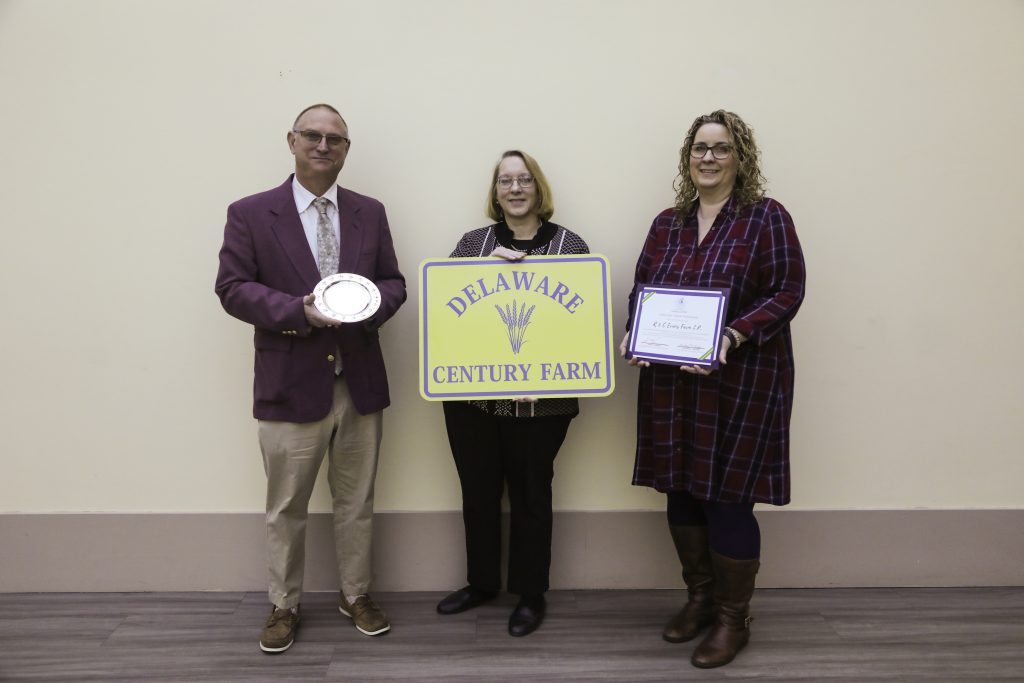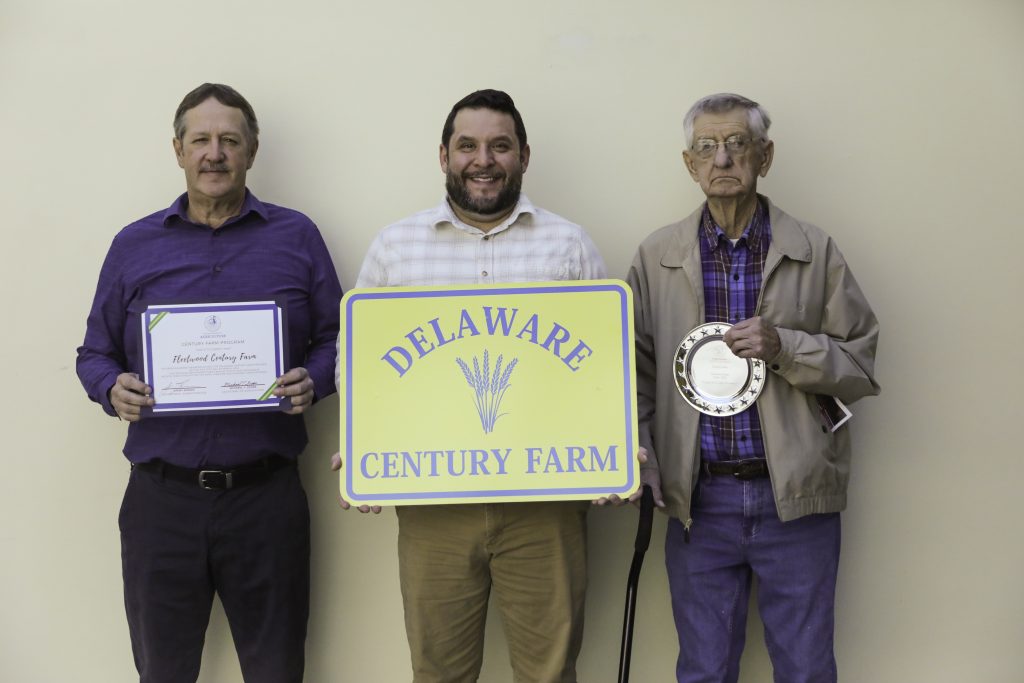DOVER, Del. (March 21, 2024) – Governor Carney, Secretary of Agriculture Scuse, and state legislators inducted three Delaware farm families into the Century Farm Program, honoring them for their commitment to keeping farmland within the family for 100 years.
“Agriculture has long been Delaware’s number one industry. Family farms built our state; in fact, there are 18 farms still in operation that are older than Delaware,” said Governor Carney. “I’m honored to be a part of this event recognizing the committed work of these three family farms who have been a part of our state’s history for 100 years.”
The Delaware Century Farm Program was established in 1987 to honor farm families who have owned and farmed their land for at least 100 years. The farms must include at least 10 acres of the original parcel or gross more than $10,000 annually in agricultural sales.
With the announcement of these three new families, Delaware will have recognized 155 Century Farms over the past 37 years. Delaware Century Farm families receive a sign for their farms, an engraved plate, a certificate, and legislative tributes.
Delaware Secretary of Agriculture Michael T. Scuse also took the opportunity to announce a new program related to long-term ownership of family farms.
“The family farm is at the heart of our number one industry – feeding Delawareans, Americans, and citizens worldwide. We want to ensure we recognize not only those farms that have been in production for 100 years but also the 24 farms that have already received this award and have kept the farm in the family for 200 years or more,” said Secretary Scuse. “The Delaware Department of Agriculture has created a new ‘Multi-Century Farm Award’ to highlight these farms, including a new lane sign denoting this achievement.”
2024 Delaware Century Farm Awardees:
R & C Evans Farm L.P. (Harrington, Kent County): The Evans family is recognized for their 60-acre family farm located in Milford Hundred.
Mr. William Biggs, our great-grandfather, purchased the original 64 acres from Jacob Pleasonton on January 9, 1917. On January 18, 1922, he purchased 22 more acres from Mr. Pleasonton, called “Potter Land.” William laid down with his infant great-grandson, David, to nap and never awoke; in turn, the farm was passed down to David’s grandmother, Hazel Biggs Davis, on November 21, 1970. On February 1, 1990, Carolyn Davis Evans and her husband, Reginald Evans, purchased the farm from her parents. For estate planning purposes, on October 31, 2005, the farm became known as R & C Evans Farm. Carolyn lived on the farm until her passing on July 4, 2021, and Reginald lived there until he passed on December 26, 2023.
The farm remains in the family, where they raise grain crops on 60 acres of farmland. While times have changed from when William Biggs tilled the land behind a mule to today’s technology, the same dinner bell remains on the pole that called generations of family members in to eat around the family table. David’s sister remembers watching Al Johnson flying his bi-wing crop duster over the farm and waggling his wings to say hello. They both look to keep the farm in the family for future generations.
 Picture (L to R): David Evans, Linda Samulevich, and Heather Evans accepted the Century Farm Award posthumously for Carolyn and Reginald Evans.
Picture (L to R): David Evans, Linda Samulevich, and Heather Evans accepted the Century Farm Award posthumously for Carolyn and Reginald Evans.
Fleetwood Family Farm (Laurel, Sussex County): The Fleetwood family was honored with the Century Farm Award for their 35-acre farm in Broad Creek Hundred.
Earl C. Fleetwood and his wife, Blanche, purchased the original 55-acre farm from Robert T. and Nancy J. Spicer on November 17, 1920, for $2,500. The farm was bequeathed to his son, Roland V. Fleetwood, when Earl died in June 1978. Roland and his wife, E. Jean Fleetwood, are the current owners of the farm.
The family currently farms 35 acres; the property still has the original farmhouse built in 1845. Additional farm buildings included a chicken house built in 1961, a garage in 1965, and a shed in 1980. Over the years, the family has raised corn, beans, strawberries, melons, tomatoes, and poultry.
 Picture (L to R): Todd Fleetwood, son; R.T. Fleetwood, grandson; and Roland Fleetwood accepted the Century Farm Award.
Picture (L to R): Todd Fleetwood, son; R.T. Fleetwood, grandson; and Roland Fleetwood accepted the Century Farm Award.
Warnick Family Farm (Greenwood, Sussex County): Valerie Warnick was presented with the Century Farm Award for their family farm located in Nanticoke Hundred.
The original farm was purchased by Gideon E. Hershberger and his wife, Susanna on September 1, 1914, from Josiah B. Hostedler. After Gideon passed away, Susanna took on the farm and left it in her will to her nieces and nephews, Dwight, Archibald, Leota, and Walter Warnick in 1941. On January 24, 1944, the farm was purchased by Dwight and Sue Warnick. While Sue passed away on October 17, 1956, Dwight continued to farm the land until he was 85 and then rented the land to two local farmers until he died on April 8, 2011. He was 102 years old. Dwight left the farm to his children, Mary Kathryn Warnick and Donald L. Warnick. Mary Kathryn lived on the farm until October 2011. The farm was purchased on June 19, 2015, by Edward C. Warnick and his wife Valerie. In January 2022, Edward passed on, leaving the farm to Valerie. They have three children, Ashley, Blake, and Wade.
The family still uses the original farmhouse. Over the years, the Warnick Family has grown corn, soybeans, wheat, and rye. They also grew chickens for many years; at some point, family members had dairy cows, beef cattle, and pigs.
 Picture (L to R): Evelyn Shahan, Blake, Natalie, and Stephanie Warnick, Ashley Warnick Heuchling, Valerie Warnick, Logan, Ava, and Zane, Mary Kathryn Warnick, Samantha, Wade, and Kylie Warnick, and Jean Warnick Kenton and Harvey Kenton were present to support Valerie in receiving the Delaware Century Farm Award.
Picture (L to R): Evelyn Shahan, Blake, Natalie, and Stephanie Warnick, Ashley Warnick Heuchling, Valerie Warnick, Logan, Ava, and Zane, Mary Kathryn Warnick, Samantha, Wade, and Kylie Warnick, and Jean Warnick Kenton and Harvey Kenton were present to support Valerie in receiving the Delaware Century Farm Award.
###